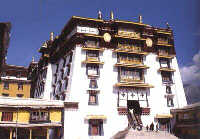|
Potala Palace
( 2005-10-27 )
Built against the terraced slope of the hill, the structures combine to from a huge sky-scraping mass, reminiscent of the divine realm above the mortal world. The granite walls elaborately decorated with soft white thatch, the golden roofs decorated with big gilded bottles, and the splendid curtains and banners join to form a unique structural wonder bearing the striking colors red, white, and yellow characteristic of Tibetan architectural art, making the Potala an eminent representation of traditional Tibetan and Chinese construction.
As the winter residence of the successive Dalai Lamas, the Potala formerly served as the center of local Tibetan theocratic rule, hosting major religious and political ceremonies since the reign of the 5th Dalai Lama, while at the same time housing the relics of those spiritual leaders.
The main portion of the Potala contains the White Palace and the Red Palace.
 White Palace White Palace
 The 7-story White Palace contains the living quarters of successive Dalai Lamas and their tutors. The offices of the old Tibetan governments and their assembly halls are also located there. The 7-story White Palace contains the living quarters of successive Dalai Lamas and their tutors. The offices of the old Tibetan governments and their assembly halls are also located there.
The most spacious hall, the Eastern Main Hall (Sishe Phuntsok), occupies a central area of 717 square meters on the 4th floor. It was there that the Dalai Lamas were enthroned as supreme Tibetan Buddhist spiritual leader and the region's temporal ruler.
The 5th and 6th floors bore government offices and rooms for the officials. Two particular apartments on the top floor, reserved for the Living Buddhas, were known as Eastern and Western Sunshine Apartments for their long access to sunlight.
 Red Palace Red Palace
In contrast, the Red Palace consists mainly of the spiritual leaders' stupa tombs and the shrines.
Of the 8 stupa-tomb halls, the most magnificent is that for the cult of the 5th Dalai Lama. To the west his memorial hall, the Western Main Hall, covers over 680 square meters, constituting the largest hall in the Potala. Of the extensive murals there the most notable one shows the patriarch's meeting with Emperor Shunzhi in 1652 of the Qing Dynasty (1644-1911) in Beijing. It was after this meeting that the title "Dalai Lama" was bestowed on him and successive leaders of Tibet.
|

